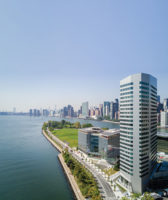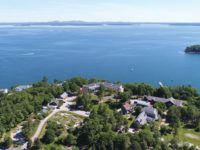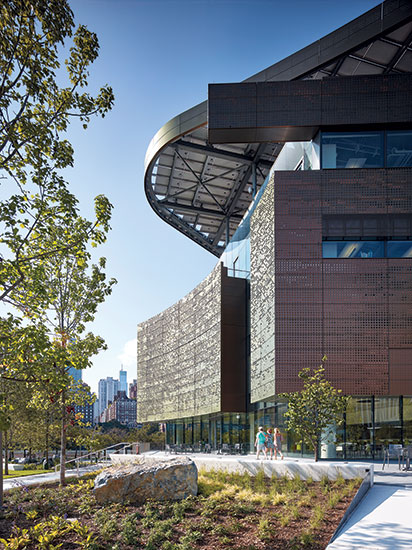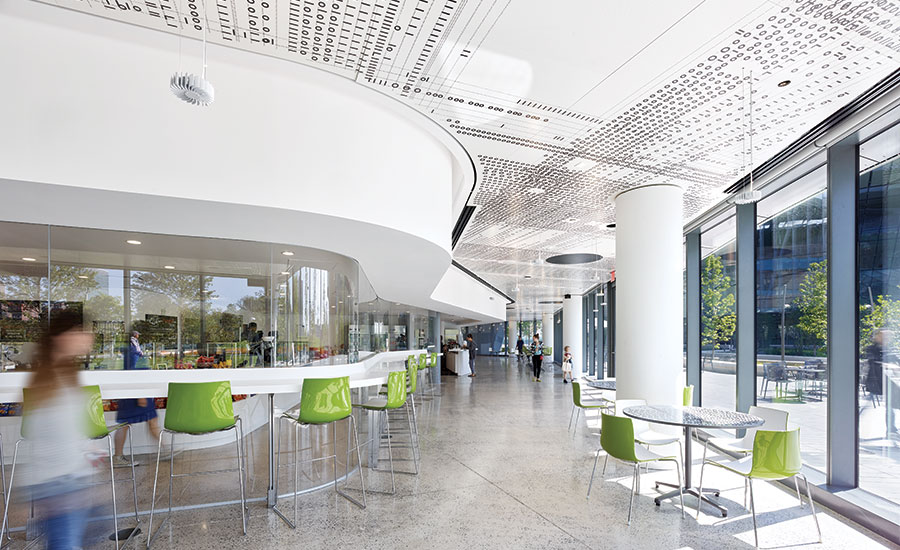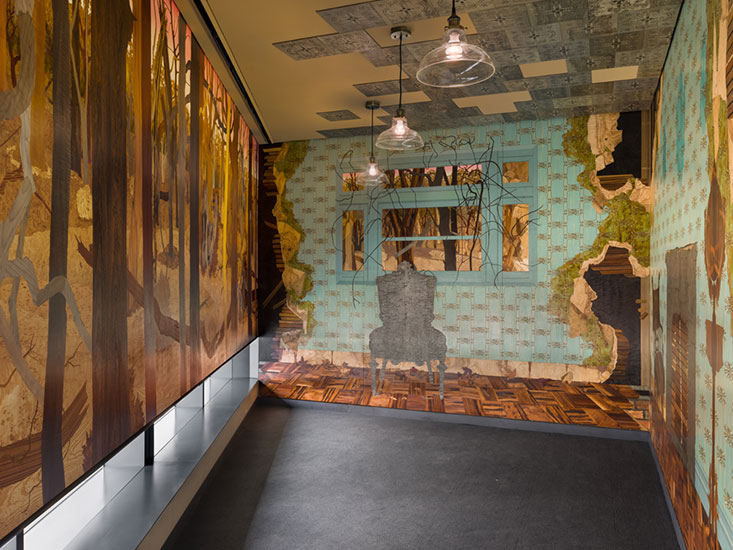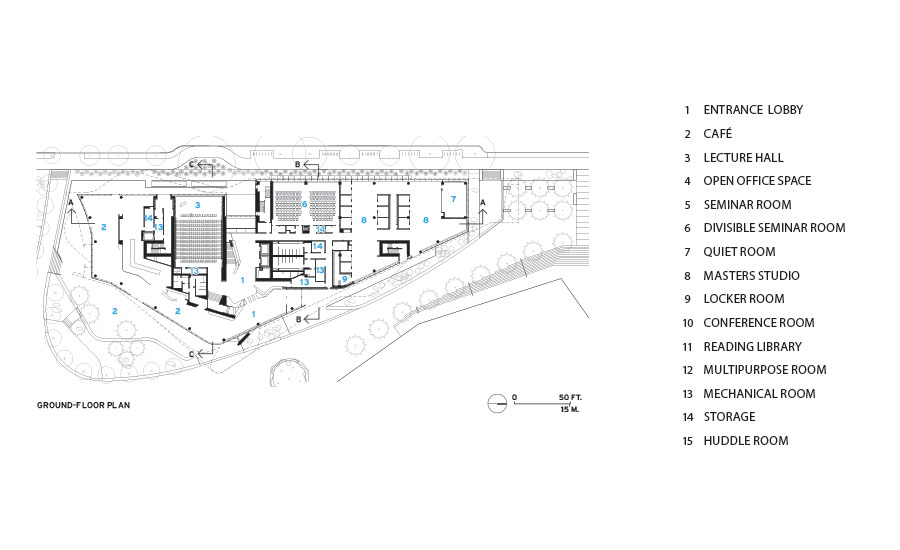Bloomberg Center by Morphosis Architects at Cornell Tech
New York City

Morphosis has designed an aluminum rainscreen wall system, which maximizes insulation values and minimizes thermal bridging for the building. The hope is to achieve net zero status.
Photo © Matthew Carbone

The lily pad–shaped solar canopy, carrying photovoltaic panels, juts like a visor over the southern end of the Bloomberg Center.
Photo © Matthew Carbone

The café at the entrance to the Center is open to the general public. Highlighting the swerving counter and soffit is an expansive artwork by Michael Riedel. Titled Cornell Tech Mag, the piece is a black-and-white inkjet print on acoustical ceiling panels and is also silkscreened on the café’s tabletops.
Photo © Matthew Carbone

At the entrance, a four-story part of the atrium is given drama by the curving balustrades and bowed walls.
Photo © Matthew Carbone

A long, three-story-high galleria extends along the western portion of the Center. Here glass boxes on the third and fourth levels seem to float in the space, overlooking the locker pavilions adjoining reading tables below.
Photo © Matthew Carbone

Cornell Tech Mag, Michael Riedel (café ceiling and table tops, ground floor)
Photo by EPW Studio/Maris Hutchinson

Everything that Rises Must Converge, Matthew Ritchie (entry atrium, ground through fourth floors)
Photo by EPW Studio/Maris Hutchinson

Ordinary objects of Extraordinary Beauty, Matthew Day Jackson (meeting room 238, second floor)
Photo by EPW Studio/Maris Hutchinson

Reclamation, Alison Elizabeth Taylor (meeting room 477, fourth floor)
Photo by EPW Studio/Maris Hutchinson

Image courtesy Morphosis Architects

Image courtesy Morphosis Architects

Image courtesy Morphosis Architects

Image courtesy Morphosis Architects

Image courtesy Morphosis Architects

Image courtesy Morphosis Architects















Architects & Firms
The first academic building at Cornell Tech, the Emma and Georgina Bloomberg Center, is a gleaming, bold statement on the new island campus for Cornell Tech, a partnership of Cornell University and Technion-Israel Institute of Technology. Its muscular, athletic stance, where a solar roof of 1,464 photovoltaic (PV) panels is boosted above four stories of teaching spaces, exultantly declares we have arrived about this adventurous step in bringing digital education and entrepreneurship together. Yet Thom Mayne, the design director and founder of Morphosis Architects, a Los Angeles– and New York–based firm, brushes off the implication that an arresting expression was intentional for this graduate computer-science and engineering facility. “I don’t design icons,” he says without irony—even though academic buildings by Morphosis such as Gates Hall at Cornell’s Ithaca, New York, campus, or Emerson College in L.A. do stand out forcefully from the crowd.
Additional Content:
Jump to credits & specifications
Mayne invokes sustainability—particularly the Bloomberg’s lily pad canopy of PVs—as the foremost generator of his scheme. It is only the tip of the hat to an array of green features such as geothermal wells, and a rainwater-collection system for the all-electricity (no combustion) building. The overall desire is to attain net zero energy, with the building producing, over the course of a year, at least as much energy from renewable sources as it consumes. Morphosis originally envisioned a roof of PVs that would float across the pedestrian plaza and central circulation spine to The Bridge building by Weiss/Manfredi on the eastern side of the site to provide enough energy to meet the goal. Ultimately the idea was scaled back so that each structure has its own solar canopy: the Bloomberg Center’s is 40,000 square feet. Taken with The Bridge’s, the two arrays create the equivalent of a 900-kilowatt system. Whether the center proves to be “zero” or only “lite” will be answered by future monitoring.
To cut energy consumption, however, Morphosis clad the Bloomberg Center in a rainscreen wall system that maximizes insulation values and minimizes thermal bridging. In addition, the outermost layer is punched with 2-inch circular tabs and coated in an iridescent polymer film. “We wanted a dynamic facade,” says Ung-Joo Scott Lee, Morphosis principal. To get the full optical effect, the architects worked with Zahner, the architectural-metal fabricator, and received digital input from Cornell and MIT students.
The iridescent, sparkling exterior skin is cut away so that bands of glazing do admit light to an array of educational spaces but maintain the recommended 60:40 ratio of wall surface to glass. Open classrooms are located on the western side of the building, facing Manhattan, and 76 small “huddle” rooms, where three or four people can meet, are on the east, oriented toward Queens. The huddle rooms evolved out of the desire by Daniel Huttenlocher, Cornell Tech dean and vice provost, to encourage an improvisatory exchange of ideas among the students and faculty. Whether these remain unassigned spaces or are appropriated by faculty members is unclear.
To ensure a fluidity of space that might spark spontaneous interaction, Morphosis placed a four-story atrium (five-story along the west) at the center of the building, anchored by an expansive stairway. At the second level, ancillary stairs take over the circulation. One veers into a curved appendage that protrudes outside the main volume of the building; its steel structure helps prop up the solar-canopy roof, which otherwise depends on the extension of the Center’s steel columnar grid for support.
The atrium’s curvilinear walls, plus a stair’s glass enclosure, along with artist Matthew Ritchie’s resin, glass, and ink, 80-foot-high mural create an active core for the Center. In addition, a long galleria cut north–south through three stories of the western portion of the building offers another opportunity for casual encounter. Here five glass boxes for collaboration appear to float high in the void. (They are actually cantilevered from the steel frame.) Although the interior is more crepuscular than The Bridge across the plaza, skylights introduce illumination, while the white solid surfaces of the lockers on the second floor and polished concrete floors help bounce light.
The café, at the main entrance facing the plaza and Tech Walk, is open to the public. Its swooping, white, serpentine counter and the lowered ceiling soffit are handsomely offset by an inkjet artwork by Michael Riedel printed on the acoustical panels of the ceiling and silkscreened on the café tabletops. Adding an unusual note, a series of “discovery rooms” contain art installations by Alison Elizabeth Taylor and Matthew Day Jackson. But the most surprising one has a striking 50-foot-long mural by Ilya Bolotowski from 1941 that was painted for the WPA program and salvaged from the Goldwater Memorial Hospital formerly on the site. (Another mural from Goldwater by Albert Swinden has found a home in The Bridge.)
If art seems unusual for a high-tech school, so are the grassy terraces, the variegated plantings, and the contoured lawns by James Corner Field Operations. They unite the exterior spaces around the Center with its neighbors, creating numerous places for socializing in good weather. With its glinting skin that turns different colors in the sunlight, the Bloomberg Center is a strong and welcome presence for the approximately 300 master’s and Ph.D. students and 30 faculty members now using it. In deference to the architect, let’s not call it an icon. But it helps that a by-product of functional and environmental concerns is a magnetic work of architecture.
Next case study: The Bridge by Weiss/Manfredi
Back to "Cornell Tech Dreams Big on Roosevelt Island"
CreditsArchitect: Morphosis Architects 153 W 27th Street, Suite 1200 New York, NY 10001 212.675.1100
Personnel in architect's firm who should receive special credit: Thom Mayne FAIA Ung-Joo Scott Lee, AIA Edmund Ming-Yip Kwong Jerry Figurski, AIA Assoc. Debbie Chen, RA Stuart Franks Farah Harake Cory Brugger
Engineers ARUP Engineers: SMEP, Façade, Lighting, Acoustic, TelCom, Fire Alarm, Fire Protection, Audio Visual, BMS Controls, Sustainability.
Consultants Waterproofing: Henshell and Buccellatto Consulting Architects Geotechnical: Mueser Rutledge Consulting Food Services: Jacobs Doland Beer Cost Estimating: Dharam Consulting Graphic Design: Pentagram Building Code: Code Consultants, Inc. Specification: Construction Specifications, Inc.
Visualization: Kilograph, Morphosis
General contractor: Barr & Barr
Photographer: Iwan Baan/ Matt Carbone |
SpecificationsStructural System Manufacturer of any structural components unique to this project: Base Building Structural Steel: Beauce Atlas Miscellaneous Metal: Crystal Metalworks PV Steel Support: Koenig
Exterior Cladding Metal Cladding: Zahner Unitized Façade/ Rain Screen: Island Exterior Fabricators Exterior Glazing: W&W Glass Curtain wall: YKK Other cladding unique to this project: Flat and Curved IGU: Cristacurva
Roofing Built-up roofing: Sarnafil/Sika Tile: Sarnatherm Heavyguard
Windows Metal frame: YKK
Glazing Interior Glazing: Infinite Glass and Metal Skylights: LineEl Dome skylights: Wasco
Doors Entrances: Dawson Balanced Doors
Interior Finishes Acoustical ceilings: Lindner, Baswaphon, Armstrong Suspension grid: Steel Ceilings Operable partitions: Hufcor Cabinetwork and custom woodwork: Kundig Contracting Paints and stains: Benjamin Moore, Idea Paint Solid surfacing: DuPont Corian Floor and wall tile: Interface, Daltile Special interior finishes unique to this project: 3Form Varia Eco Resin Wall Paneling Interior Shades: Mechoshade Interior Gypsum Prefabricated Products: Plasterform
Furnishings Office furniture and seating: Teknion, Herman Miller, Vitra, Wilkhahn, Andreu World, Allermuir, Fixed seating: Theatre Solutions Tables: Herman Miller Other furniture, phone booths: Martela/Framery.
Lighting Interior ambient lighting: HE Williams, Linear Lighting, Lucifer Lighting Co. Downlights: USAI BeveLED Exterior: Architectural Lighting Works Dimming system or other lighting controls: Crestron Stretch Fabric Ceiling: Newmat
Conveyance Elevators/escalators: Kone
Plumbing [putting each product on a separate line, enter in this way: "Product: Manufacturer Name"] Water closets and urinals: ToTo Faucets: Toto Hand Dryer: American Specialties Inc. Toilet partitions: ASI, Global Partitions Custom restroom sinks: Kundig Contracting
Energy Photovoltaic panel: Solaria Photovoltaic system: Entersolar Other unique products that contribute to sustainability: Rain Water Harvesting System and Control by: Highmark and Aquanomix. Reclaimed oak from sitework: Kundig Contracting
|



